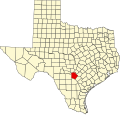History
Martinez was a station on the Galveston, Harrisburg and San Antonio Railway in 1877. Its population was 50 in 1910, with a store owned and operated by W.C. Schlather. It remained the same in 1940, with the opening of three more businesses. It continued to grow slowly, with the population reaching 75 in 1990. It was listed on county maps in 2000, but with no further population records. [3] In the 2020s, it has a population of 27,466. [2]
Demographics
Historical population| Census | Pop. | Note | %± |
|---|
| 1970 | 1,383 | | — |
|---|
| 1980 | 5,150 | | 272.4% |
|---|
| 1990 | 8,887 | | 72.6% |
|---|
| 2000 | 11,508 | | 29.5% |
|---|
| 2010 | 18,198 | | 58.1% |
|---|
| 2020 | 27,466 | | 50.9% |
|---|
|
As of the 2020 United States census, there were 27,466 people, 8,435 households, and 6,176 families residing in the city. The population density was 1,818.3 inhabitants per square mile (702.0/km2). The 4,009 housing units averaged 633.4 per square mile (244.5/km2). Of the 8,435 households, 44.6% had children under the age of 18 living with them, 61.5% were married couples living together, 14.5% had a female householder with no husband present, and 19.8% were not families. About 15.5% of all households were made up of individuals, and 3.2% had someone living alone who was 65 years of age or older. The average household size was 2.94 and the average family size was 3.26. [6]
In the city, the population was distributed as 31.0% under the age of 18, 8.0% from 18 to 24, 33.9% from 25 to 44, 20.8% from 45 to 64, and 6.4% who were 65 years of age or older. The median age was 32 years. For every 100 females, there were 95.5 males. For every 100 females age 18 and over, there were 89.2 males. [6]
The median income for a household in the city was $47,947, and for a family was $49,396. Males had a median income of $32,631 versus $25,765 for females. The per capita income for the city was $18,949. About 4.9% of families and 6.5% of the population were below the poverty line, including 8.5% of those under age 18 and 10.5% of those age 65 or over.
This page is based on this
Wikipedia article Text is available under the
CC BY-SA 4.0 license; additional terms may apply.
Images, videos and audio are available under their respective licenses.


